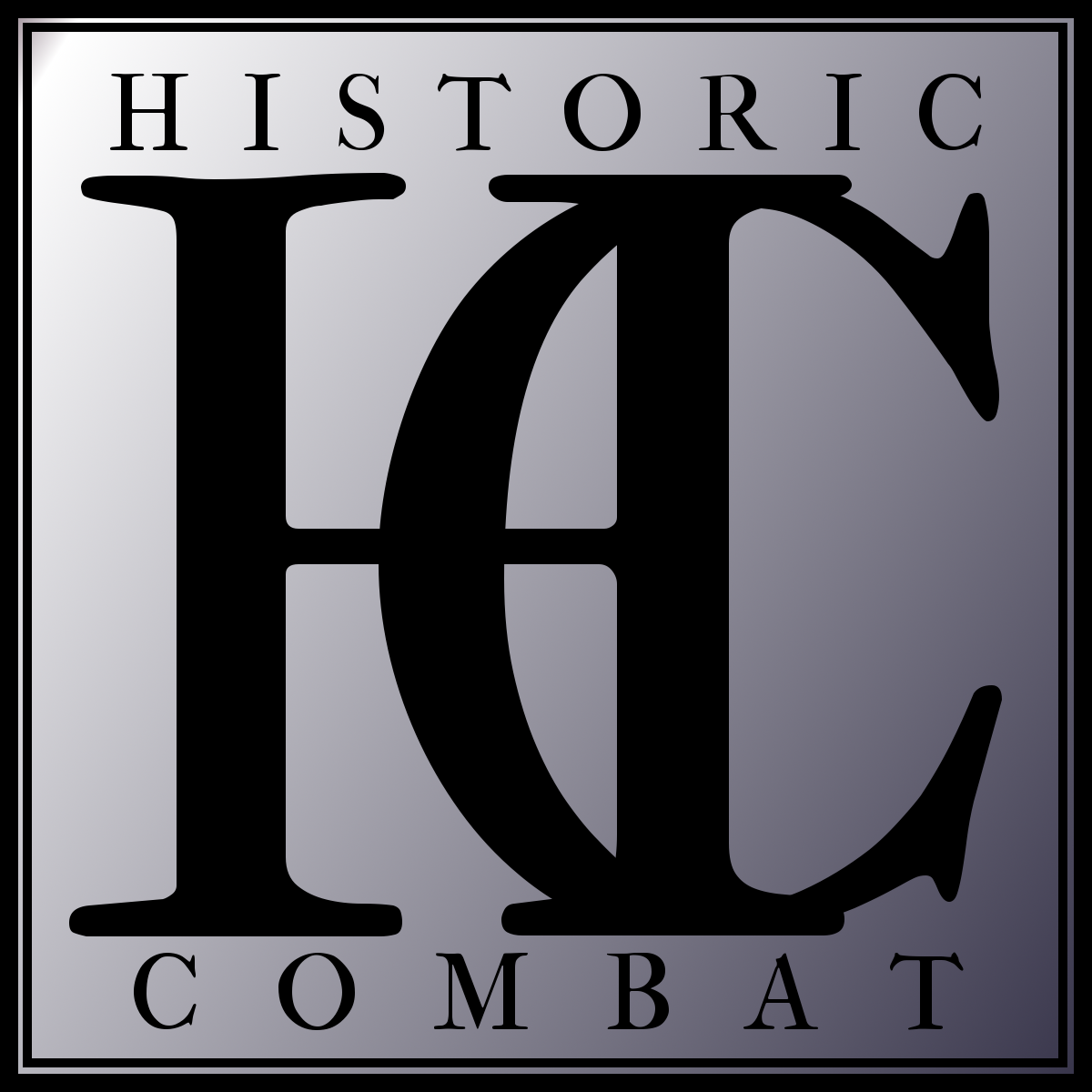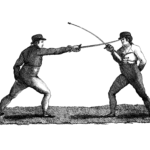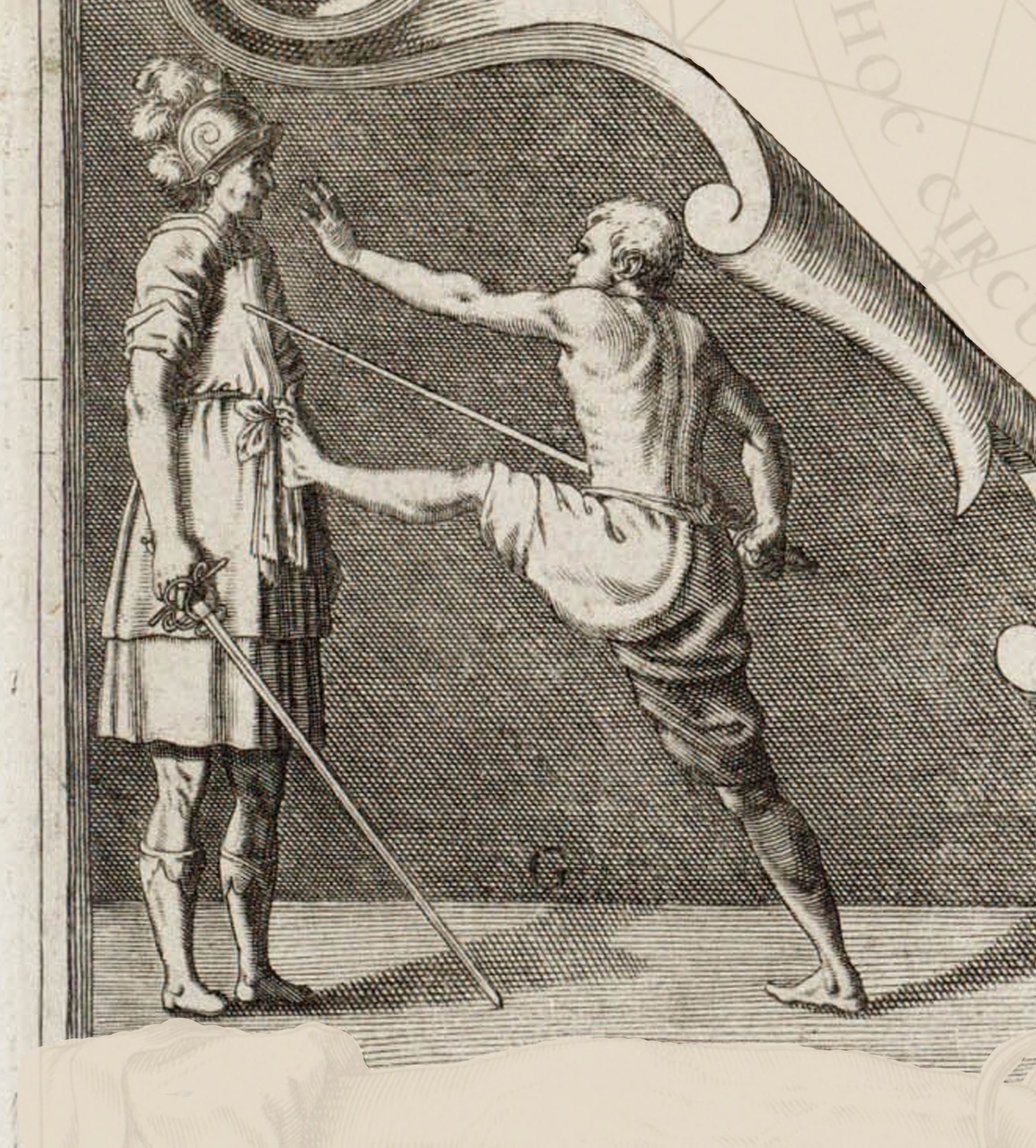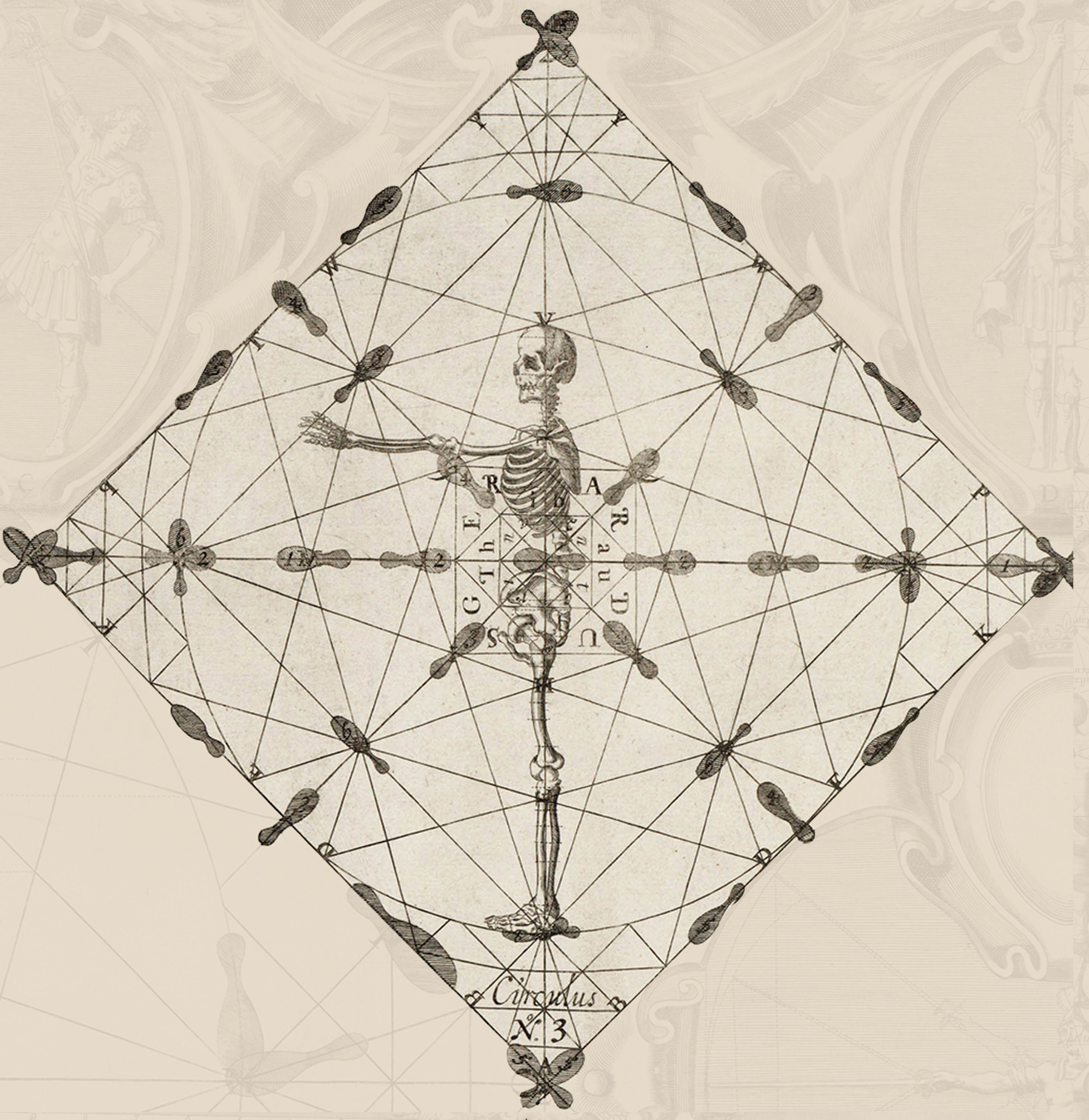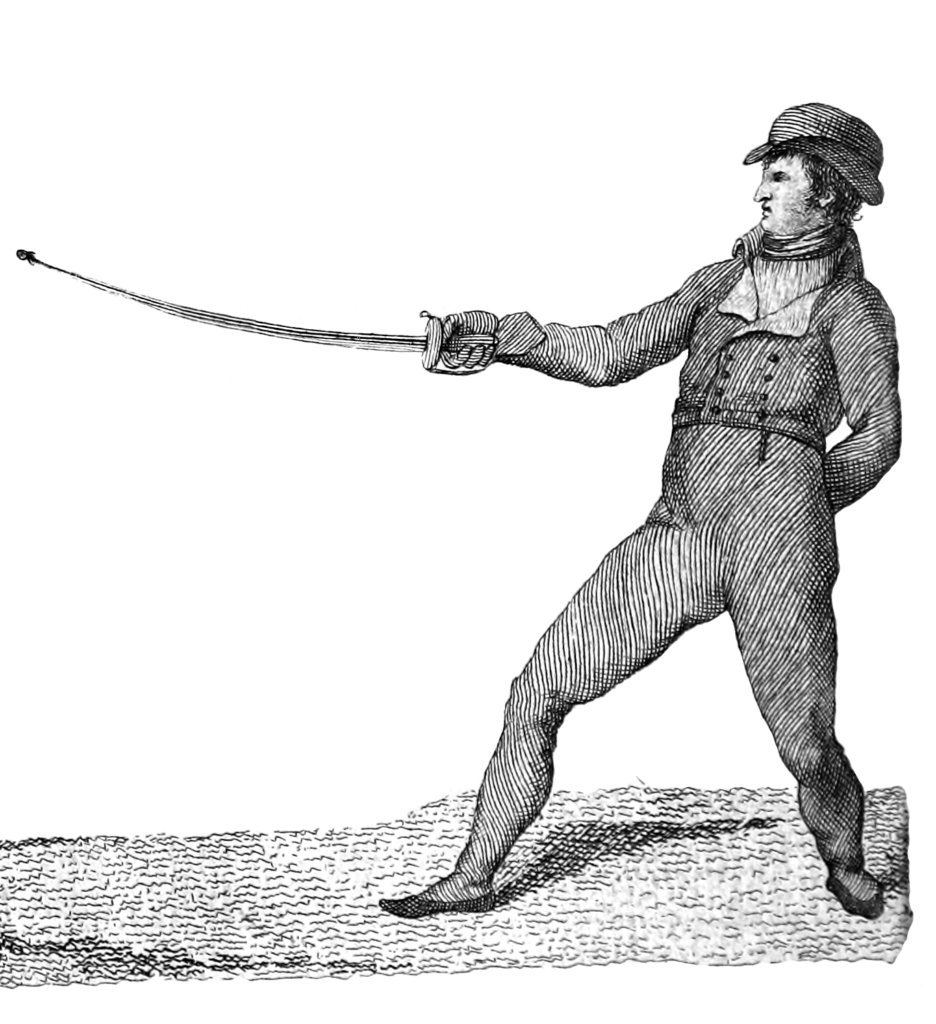328. Concluding on the execution of the shots requires more knowledge of everything that looks toward the operation, none less than the exact movements of the removal. For, although each of the removals must be done at a certain point, poor skill or lack of attention, or any other reason will cause the enemy to vary, making them higher, or lower, more open, closed, etc and, as to secure the guard of the adversary, it is essential to keep your hand where it is, without having sufficient security of this place will make it impossible to take if you fail to give due attention to this. More than this, the one who intends to offend does not rest while his object is not yet achieved, as he might be punished when discharging the offense as it begins, by the one who attacks or by the one who defends during the formation of another. Therefore, without taking advantage of the moment when the shot ends, there is no other suitable to conclude. Then it is indispensable to more of the knowledge said, and a little agility. Any conclusion practiced on the offence, executed from defensive measure, should be completed on the tangent O-P of the same plate 12, passing through the center of the enemy’s own circle which is the tangent of your own circle of defensive measure, except for when you leave the line of the diameter on the right side in the execution of the offense on which it is to be concluded so, leaving these stated points, the stated compass becomes impracticable and, in this case, it is enough to go with him to the line of points B and 4, to make the conclusion, which will be present as a general rule.
Conclusion on the Thrust of Fourth
329. If the enemy is presented, affirmed in the guard of third and the defensive stance on the points b and V of his own circle B-B, plate 12, take the offensive stance in the circle A-A and, from the common guard, direct a thrust of fourth, step to the inner circle 3-3-3-3, as shown in point C, and raise the left foot at the same time that your competitor goes to the removal of fourth. Carry with great speed to point Q taking his guard by the high outside, holding it down, and immediately passing the right foot to point R, turning the right hand to third with engagement of the weapons, restraining the enemy by presenting the point to his chest.
Opposition to the Conclusion
330. The opposition to the conclusions on shots admit the Spanish withdrawal and, taking the right foot out on its diagonal, labeled with the letter S in the point that it occupies, having left the one it occupied in b, the center of its circles, and the left takes the direction represented by T. Given what was said when the opposite advances with the thrust, you will see the movement of the left foot to enter for the conclusion. Execute your leap back without abandoning the removal of fourth. However, if you intend to offend, withdraw your foot on the diagonal, to take fourth or fifth, and inflict a thrust by the weapons.
Transferring the Conclusion
331. To transfer this conclusion, it is necessary that, immediately as the enemy undertakes to secure the guard, the sabre is collected in low fourth, securing the contrary guard by the low outside, raising to the height of the superior plane and turning the hand in third, placed in line with the right vertical, presenting the point below the enemy’s arm. These operations begin and end with the compass designated in Z and d, the left corresponds to points V and Z and the right to points b and d. The variation that this transfer admits is that, leaving the left foot firm in V, the right then leaves b on its diagonal to point S, and the rest will be done as explained.
Conclusion on the Thrust of Third
332. When the enemy has asserted in the guard of fourth and you intend to conclude on the first thrust, throw one of third, move square and advance to the inner circle (which is marked by the places J and Y) and then go to the removal. Secure their guard by the low outside, but for this, it is necessary to leave the enemy’s sabre on your left side, enter to the inside of it and lay your hand on the low outside to be able to hold the blade under the arm, free your own sabre below the other, and place the guard at the height of the right eye, perpendicular to the vertical of the same side, directing the point to the face of your adversary to contain it, being careful as in the previous to unite with these rules the compass Q, R.
Opposition to the Conclusion
333. If this opposition is believed to be be conducive to leaving with the Spanish leap back, there is no need to move the arm from the place that it occupied in the removal. However, if you prefer to take your foot to the diagonal S, turn the hand to fourth at the same time, extend the arm, and direct a thrust of first with union of the weapons to the diameter of the chest, with only a balance forward.
Transferring the Conclusion
334. When you intend to transfer this conclusion, be careful of the moment when the enemy is advancing on the guard, for in this same, gather the sabre to low third, taking the contrary guard by the low outside, raising to the superior plane, and turn the right hand in fourth to carry the enemy sabre to the left vertical with the strong of your own weapon, presenting the point to the chest or below the arm, and pass to the points Z and d, or remove the right to S in the case of any obstacle.
Conclusion on the Thrust of First
335. When you see the contrary affirmed in the guard of fifth and standing to defend, throw a thrust of first with the deep step as explained and the removal of sixth should be made. Join the elbow to the right vertical, putting the hand a little toward the diameter of the chest, removing the point further on the side it is on. Hold the enemy sabre with this type of low third and, raising the left foot e, take it to the point Q. In this same time, take the contrary’s guard by the low outside and force it up, following with the right foot to occupy the point R. From there, lower the point to the body and inflict a thrust of low first if appropriate. All of the movements that make up this conclusion should be so united and prompt that there is no difference of time between one and the others, because in suffering the smallest delay, the attempt will become impossible, the opposite will establish the conclusion, making the most of the advantage that laziness provides.
Opposition to the Conclusion
336. To oppose this conclusion, the thrust of first is assumed to be thrown and have been parried with sixth. By virtue of this, then, the enemy will advance on your thrust to the guard. The one who removes will go out with a Spanish leap back, but if you wish to offend, instead of the leap, serve the right foot to point S and proceed to the corresponding opposition. Inflict a thrust of first by the sabre with the hand in third, or raise the point by the outside on the arm of the contrary, with only the wrist, one third of the weapon before the opponent graduates yours with the removal of third.
Transferring the Conclusion
337. When it comes to transferring the conclusion, take care to seize the moment when the enemy is advancing on the guard, for in the same, pick up the arm with the removal of first and, giving the left hand the necessary reach, secure the contrary as stated in the conclusion on the removal of first from paragraph 314, and accompanied by the compass Z, d or removing to the point S with the right foot.
Conclusion on the Thrust of Second
338. If the contrary has affirmed in the guard of sixth, intending to conclude, throw a thrust of second with the step J, Y, which must be repaired with a removal of fifth. Secure the guard by the low outside, making the hand circle above the contrary, from the inside to the outside, asserting the blade under the arm. But be careful that when you throw yourself on the guard of the enemy’s weapon, you enter below so that the point of your sabre is outside of your left vertical. All of this will be accompanied by the compass Q, R as I have said previously. You can also take the guard on the inside leaving the left arm fully extended and walk with the compass to the points described, raising the arm and sword of the enemy toward the contrary’s back, depriving it of the action of bending by the elbow.
339. In addition to the variation that I have just announced, this conclusion supports yet another. The one who repairs can, instead of fifth which I have just explained, go to low fifth, leaving the point within the planes or directed to the body, as required by the nature of this removal. In this case, at the time of entering to throw the guard, you must contain the enemy’s sabre with a removal of second in order to remove the point to the right vertical and, by virtue of the different situations that the weapons take, the guard will be secured by the outside below your own sabre, or both, to inflict a thrust with weapons joined.
Opposition to the Conclusion
340. If the opposition to these conclusions is to be done by withdrawing, there is no need for another operation than leaping back. But, if you intend to offend, pay consideration to the removal with which the thrust was repaired. If the regular fifth was used for this, at that time take the foot to point S with the necessary opposition of the arm and sword. Inflict a thrust of second by the sword. But, if he made low fifth it is necessary to free the point above with the least possible movement at the time of the exit and execute a thrust of first with opposition to the inside.
Transferring the Conclusion
341. To transfer the conclusion on the thrust of second, it is necessary that, at the same time the enemy throws themselves on the guard, the sabre is collected to the removal of second, or low fourth as much as possible to remove the reach, and move square to extend the left hand, securing the contrary guard by the high outside and pass immediately to the points Z and d. Lowering the two weapons to the median plane without disengaging your own, present the point of this to the chest with the hand in third, taking care that these operations and those of the inferior plane preserve the unity of time that they must.
Conclusion on the Cut to the Head
342. To make this conclusion, and the one following, requires the execution of a second shot. Therefore, assume the guard of the enemy will be first a thrust of third, having stepped with it to the point Y, which, being repaired with the removal of the same name, gives disposition to execute a cut to the head which is removed with high fourth, providing the advance on the contrary guard, so that, securing it by its high outside, pass to the points Q and R, making the same conclusion as that in paragraph 320.
Opposition to the Conclusion
343. If the opposition to this conclusion is made with a leap back, bring the sabre to fourth of the first order. However, if it is to be done with offense, read paragraph 321.
Transferring the Conclusion
344. To transfer this conclusion, after the movement of the enemy’s left hand is noted, with the utmost violence, carry the sabres to low fourth, move square, and practice the conclusion taught in paragraph 305, entering at the same time to the points Z and d.
Conclusion on the Reverse to the Head
345. This conclusion, like the prior one, requires the previous execution of two shots, the first of which must be a thrust of fourth, and the second a reverse to the head which, to repair, requires high third, in which virtue, having made the step for its execution to the points Y and J, you achieve the necessary disposition to secure the enemy’s guard on its inside, turning the left hand in fourth, and put the blade below the arm, making a conclusion the same as that in paragraph 323, occupying the points Q and R with the feet.
Opposition to the Conclusion
346. If the opposition is made by leaping back, lower to third of the first order, but, if you have taken your right foot out on your diagonal S, read paragraph 324.
Transferring the Conclusion
347. After you see the movement of the enemy to secure the guard, join your elbow to your right vertical and, with only the wrist, raise the point until you put the sabre perpendicular and, from there, continue the movement of the arm and sword to low third, extending the left arm at the same time to secure the contrary guard by the low outside. Raise these to the height of the superior plane and turn the right hand to fourth. Move the weapons together to the left vertical, presenting the point to the enemy, and passing to the points Z and D or taking the right foot out to S. All of these operations require the unity of tempo charged so many times.
Appendix
348. Although the operations explained to transfer the conclusions are sufficiently secure and arranged to the principles of the true skill, desiring even to multiply resources for the defense, I do not think it superfluous to add here that, when the violence of the enemy to throw himself to a conclusion exceeds the premeditation of the fight, you can transfer it at the time that he undertakes his journey. Pick up the sabre to the remove of the second order when it is possible from there, lay hands on the enemy’s guard, and move over the center, carrying the left foot to X on the tangent O-P, lowering the right in the center of your circle as represented by the corresponding X, doing in the rest what is convenient to transfer on each one of the six removals which are clearly explained above.
